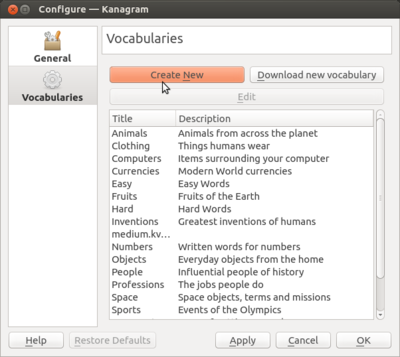ICT teacher handbook/Building vocabulary with Kanagram
Introduction
Kanagram is a very simple FOSS application for strengthening vocabulary in a language. The tool allows you to configure word lists for any given category. You can provide a hint for each word also. For instance you could define a category - 'Rivers of Telangana' and give Godavari, Krishna, Palleru, Dindi, Bhima as the words for this category. For each word you can give a hint or clue, for e.g. 'second longest river in India' for Godavari. When you 'play' Kanagram, you will select a category. If you select 'Rivers of Telangana' , you will get jumbled words, one at a time, and you need to guess the word.
How the tool supports learning of that subject
This word thus builds the vocabulary of students in an enjoyable manner. Unjumbling the word is a creative exercise, making students familiar with anagrams. Later making anagrams of any word can itself be a useful linguistic activity. The hint or clue also adds to the fun in the learning.
Apart from testing students vocabulary, you can also support student language skills by encouraging them to build word lists for different categories and provide meaningful hints/clues. (The clues need not only be literal clues, it can be cryptic also, like in crosswords). For instance, you could set the clue as 'Pandava' for Bhima River. This activity can be a base for students to explore crosswords, play the Scrabble game, which involves students identifying words from the letters they have chosen. Solving crosswords is a good language learning activity.
Kanagram allows word lists to be setup in other languages also. So you can set simple word lists in Telugu as well. (Currently Kanagram allows only simple Telugu words, complex/compound letters are not supported).
Chapter Objectives
- Understanding how to build vocabulary in a language, using a game of jumbled words
- Creating jumbled word lists for different categories, to support vocabulary building and language learning
Digital learning resources
- Handout for Kanagram
Additional Resources
Anagram maker, is a website resource which generates anagrams for any word you type in. You could have a competition in class for students to identify the maximum number of words from a word or group of letters.
Level 1 -> 2 weeks
- This activity requires two 3-period blocks over 2 weeks : 2 periods for demonstration and 4 periods for the hands-on work.
- In the first demonstration period, you can play the jumble word game with students. You can highlight following
- the jumble and un-jumbling itself
- the idea of word categories (this is similar to the 'set theory' that students will learn in Mathematics later)
- You can ask students to suggest more words for a category
- Ask them what 'hints' they would like to provide for a word. This is the opposite of what students usually do - they find answers to questions framed by others. Here they are framing questions (hints) which require / suggest answers. This can be a novel learning experience for students. You can debate and discuss hints.
- Students can play with the jumbled words in two periods. You can discuss meanings of different words that may not be clear to students. You can also ask them for equivalent words in other languages.
- If there is time, you can ask students to suggest more categories. You can ask students, in groups, to design categories, words, jumbles and hints for each word. They can type it in a text document in a table.
- In the second demonstration class, show how you have created a new category and uploaded words, jumbles and hints for each word.
- Encourage them to debate and discuss whether the words suggested belong to the category, whether there are any 'border' words where there can be varying opinions on whether the word can be included in the category, and also the suitability of the hints suggested
- Students can then upload the categories and word lists for the categories created by them, on the Kanagaram installation on their computers. If you find any additions very creative, useful, you should share in the Subject Teacher Forum so that these can be available to other schools, and also can be made available in the next custom distribution.These activities can be over 2 periods and in the last period, students can share the work done by them for peer review and feedback

